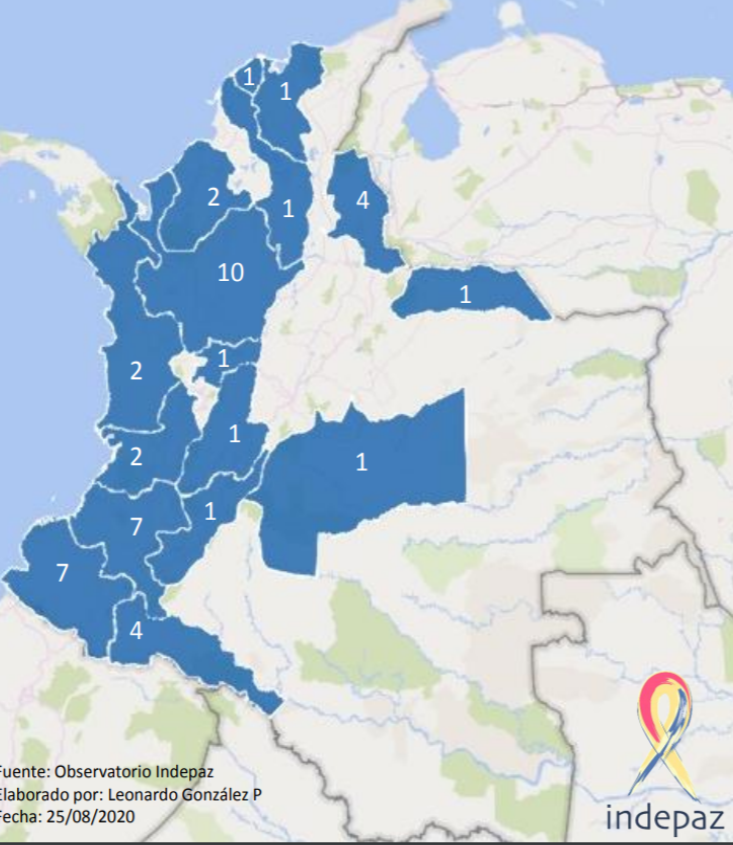The massacres’ figures for the month that just ended in Colombia are terrifying.
On August 2, in the rural area of La Gabarra, Norte de Santander, 6 peasants were massacred. On August 12, in Llano Verde, Cali, they massacred 5 children. On August 13, in Corinto, Cauca, they massacred 2 indigenous people. On August 15, in Samaniego, Nariño, 8 students were massacred. On August 18, in the Pialapí indigenous reservation, in Pueblo Viejo, 3 indigenous people were massacred. On August 21, in Tambo, Cauca, 6 peasants were massacred. On August 21, in Arauca, they massacred 5 peasants. On August 22, in the rural area of La Guacamaya in Llorente, Tumaco, 6 peasants were massacred. On August 26, on the road that connects the municipalities of Ocaña and Ábrego in Norte de Santander, they massacred 3 young people. On August 28, in the Andes, Antioquia, they massacred 3 young men. Total in August: 47.
That’s August’s list. It is incredible for many, but reality, as always, is more than fiction. So far in 2020, according to figures from the Institute for Development and Peace Studies, Indepaz, 185 people have been killed in 46 massacres. The following map shows the massacres by department and the number of people who died in each.
 Mapa de Indepaz sobre las masacres en Colombia en 2020. | Indepaz
Mapa de Indepaz sobre las masacres en Colombia en 2020. | IndepazWhat’s going on?
First of all, there is definitely a deterioration in the security of the country that is reflected in attacks on the public force, massacres and combats between criminal organizations. In addition, this year the struggle between criminal organizations and illegal armed groups became more evident.
In 2006, the United Self-Defense Forces of Colombia, AUC, better known as paramilitaries, demobilized – at least on paper. After that disarmament, a war broke out between various organizations for territories’ control. Then, in 2016, after the signing of the Peace Agreement, those clashes escalated to the point today where the victims became the communities.
But the government today continues to point fingers: Santos, peace, the guerrillas, but no one in the State is looking for a solution. The uncertainty about who is behind the massacres only contributes to making things worse.
Meanwhile, the government of President Iván Duque continues to blame the violence on the usual. As an example, this statement by Defense Minister Carlos Holmes Trujillo in an interview with El Tiempo: “Today’s massacres are the same as yesterday and for the same reasons. Ex-FARC, National Liberation Army, drug trafficking groups and criminals of all pelambres.” But the numbers tell another story.
According to the Center for Historical Memory, although all groups have used massacres as methods of control and terror, of the 1,982 that occurred between 1985 and 2012, 58% were perpetrated by paramilitaries (the same ones who had “demobilized” in 2006 ).
Added to the above is that the conflict in Colombia and, therefore, its authors, mutated. According to Christoph Harnisch, the last head of the Delegation of the International Committee of the Red Cross in an interview with El País de España, there are at least five internal armed conflicts in Colombia. With the National Liberation Army (ELN), considered the last guerrilla in the country, which has been strengthening to become the most active group; with the structure of the Clan del Golfo, that emerged from the remnants of the paramilitary groups; with the People’s Liberation Army (EPL), which has been strengthened since 2017; with the FARC dissidents, that is, those who left the Peace Process; and the last between the ELN and the EPL, who are fighting each other in some areas of the country.
As if all this were not enough, the humanitarian organization revealed that since the signing of the Peace Agreement, 466 cases of disappearances have been registered in the south of the country.
“Homicides” or “multiple homicides”
The inordinate number of massacres in August made the world turn its gaze to Colombia, even in the midst of the Covid-19 pandemic. That’s just a symptom of the obvious: someone has to act.
It is compulsory for the State to assume that role. However, the government reaction has been disappointing to say the least. Although the figures do not lie, on Saturday August 22, when President Duque arrived in Chachagüí, Nariño, the place where he traveled to speak to the community in the southwest of the country after the massacre of 8 students in Samaniego, he referred to these events as “homicides”, a term that that same day was endorsed by Defense Minister Holmes Trujillo, who described them as “multiple homicides.”
Added to this was the outrage at the statements on Twitter by President Duque for the following tweet, in which he focuses on how many deaths were due to violence between 2010 and 2018, the years of the Santos mandate, compared to the deaths between 2019 and 2020.